This is the last of a four-part series on the Doolittle Raid. For details of the actual raid, B-25 Mitchells in 1/72 scale, and diorama of the take-off in 1/72 scale, please refer to the three previous posts, The Doolittle Raid, Parts 1, 2, & 3.
As discussed in Part 2, models of only two of the 16 B-25 Mitchell bombers that participated in the Doolittle Raid have been made into diecast — Col. James Doolittle’s “02344” and Lt. Ted Lawson’s “Ruptured Duck.” Given that Corgi’s two Doolittle Raid Mitchells have essentially disappeared from the market, Corgi would do collectors a great service by releasing another B-25 Doolittle Raider — one with a new livery (i.e., different markings).
Corgi and Air Force 1 would have interesting alternatives at their disposal, as some of the other 14 B-25 Mitchells also had memorable artwork. The following passage is from Lt. Ted Lawson’s Thirty Seconds Over Tokyo, first published in 1943. The passage follows commentary regarding constant inspections of the aircraft for possible leaks. Presumably, Lawson’s plane was found to have sprung a leak.
One morning I came out to my plane and found that somebody had chalked the words “Ruptured Duck” on the side of the fuselage. I grabbed Corporal Lovelace, a gunner I knew, and asked him to paint some sort of design on the ship. He’s a good caricaturist. Lovelace got out his stuff and painted a funny Donald Duck, with a head-set and the earphone cords all twisted around his head.
Lovelace did a swell job in blue, yellow, white and red. Then he added something that gave all of us another laugh. Under Donald Duck he drew a couple of crossed crutches.
The other boys now got busy with insignias. In a couple of days a lot of hitherto anonymous B-25’s took on such names as Hari-Kari-er (a hefty hunch), Whiskey Pete, Anger Angel, Whirling Dervish, Fickle Finger of Fate and one fellow painted the chemical formula for TNT on the side of his ship.
It is clear from the passage that several of the aircraft had personalized markings and there is actually photographic support for some.
The table below summarizes what little information I could gather from various sources on the Doolittle Raid B-25 Mitchells and their names and markings, listed in the order in which they took off from the USS Hornet:
| Position | Number | Name | Markings | Insignia |
| 1 | 40-2344 | None | No Individual Markings | |
| 2 | 40-2292 | None | No Individual Markings | |
| 3 | 40-2270 | “Whiskey Pete” | Name Only | |
| 4 | 40-2282 | None | No Individual Markings | |
| 5 | 40-2283 | None | No Individual Markings | |
| 6 | 40-2298 | “Green Hornet” | Name Only | |
| 7 | 40-2261 | “Ruptured Duck” | Donald Duck Cartoon | |
| 8 | 40-2242 | None | No Individual Markings | |
| 9 | 40-2303 | “Whirling Dervish” | Tornado Cartoon | |
| 10 | 40-2250 | None | No Individual Markings | |
| 11 | 40-2249 | “Hari Kari-er” | Angel with Bomb | |
| 12 | 40-2278 | “Fickle Finger” | Name Only | |
| 13 | 40-2247 | “Avenger” | Name Only | |
| 14 | 40-2297 | None | No Individual Markings | |
| 15 | 40-2267 | “TNT” | TNT Formula Design | |
| 16 | 40-2268 | “Bat Out of Hell” | Name Only |
As is readily evident from the table, nine of the 16 Mitchells had a moniker; seven did not. Of the nine with names, four had “insignias,” as Lawson called them. Thus, our choices of liveries are limited to those four and, given that the “Ruptured Duck” has already been produced, there remain only three choices: “Whirling Dervish,” “Hari Kari-er,” and “TNT.” It is interesting to note that all three of these Mitchells were specifically mentioned in the Lawson passage quoted above.
However, it is something of a mystery why “Anger Angel,” which Lawson mentions in the passage, is nowhere to be found. Is it plane #13 “Avenger”? Did Lawson simply misremember? Is the design for “Anger Angel” lost forever? I note that since Thirty Seconds Over Tokyo was published in 1943, while memories were still fresh, it is a contemporaneous account of the episode whose accuracy should be accorded significant probative weight.
Here are the three viable alternatives:
40-2249: “Hari Kari-er”
Let’s begin with the “Hari Kari-er,” the 11th plane to take off from the Hornet, since there is ample photographic documentation for its livery. The “Hari Kari-er” is best known for downing two Japanese fighters during the mission. According to Chun in The Doolittle Raid 1942, Osprey Campaign 156, “Hari Kari-er,” piloted by Captain C. Ross Greening, was attacked by four Kawasaki Ki-61 Hiens, known as “Tonys” to Americans, on the way to Yokohama. The Hiens were still in the evaluation phase. The “Hari Kari-er” shot down two from its dorsal turret and managed to outrun the two others, subsequently dropping its bombs on an oil refinery. Please refer to the wonderful color illustration of this episode in The Doolittle Raid, Part 1.
Below is a portside photo of the “Hari Kari-er” on the Hornet, scanned from Chun’s Doolittle Raid 1942.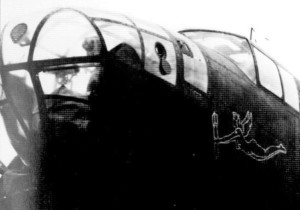 Also from Chun’s book, here’s a close-up of the insignia on the starboard side of the fuselage: the white outline of a curvaceous angel about to release a bomb. The irony of an angel ready to drop death and destruction from above should not be lost on us, biblical though it may be. Given that the Doolittle Raid occurred only four months after the U.S. entry into the war, this is likely one of the first examples of pin-up art on an American aircraft, if indeed a naked angel can be considered a pin-up. Note the dark smudge directly in front of the bomb in the angel’s hands where the name “Hari Kari-er” was overpainted in darker olive drab, though the reason is unclear.
Also from Chun’s book, here’s a close-up of the insignia on the starboard side of the fuselage: the white outline of a curvaceous angel about to release a bomb. The irony of an angel ready to drop death and destruction from above should not be lost on us, biblical though it may be. Given that the Doolittle Raid occurred only four months after the U.S. entry into the war, this is likely one of the first examples of pin-up art on an American aircraft, if indeed a naked angel can be considered a pin-up. Note the dark smudge directly in front of the bomb in the angel’s hands where the name “Hari Kari-er” was overpainted in darker olive drab, though the reason is unclear.  For those of us who love color profiles, here’s one from B-25 Mitchell, Walkaround #12, by Lou Drendel, illustrated by Don Greer, reproduced here for discussion purposes under the fair use exception to the copyright laws.
For those of us who love color profiles, here’s one from B-25 Mitchell, Walkaround #12, by Lou Drendel, illustrated by Don Greer, reproduced here for discussion purposes under the fair use exception to the copyright laws.  Finally, it’s noteworthy that the Battle 360: Season One, Call to Duty episode used the “Hari Kari-er” extensively in its computer-generated imagery video production of the Doolittle Raid. I captured the still below from that episode. Forgive the poor quality of the capture.
Finally, it’s noteworthy that the Battle 360: Season One, Call to Duty episode used the “Hari Kari-er” extensively in its computer-generated imagery video production of the Doolittle Raid. I captured the still below from that episode. Forgive the poor quality of the capture. 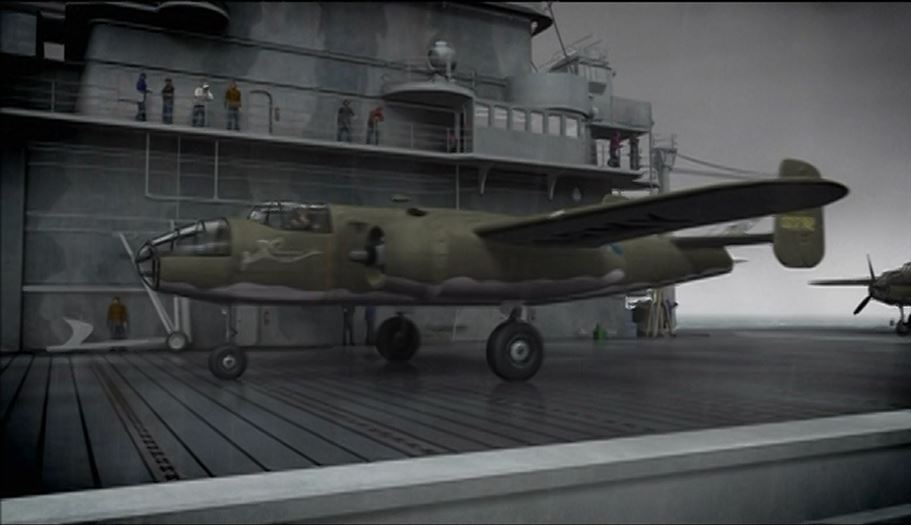 Inarguably, the “Hari Kari-er” has a terrific insignia that makes it a worthy candidate for Corgi or Air Force 1 to make it into a diecast model. The probability that it was the first American plane to down a Japanese Hien in addition to the possibility that it was the first American plane of the war to display pin-up art makes the “Hari Kari-er” irresistible.
Inarguably, the “Hari Kari-er” has a terrific insignia that makes it a worthy candidate for Corgi or Air Force 1 to make it into a diecast model. The probability that it was the first American plane to down a Japanese Hien in addition to the possibility that it was the first American plane of the war to display pin-up art makes the “Hari Kari-er” irresistible.
40-2303: “Whirling Dervish”
The 9th plane to take off from the Hornet, the “Whirling Dervish” is credited with shooting down a Japanese fighter while completing its mission to bomb a tank factory in the south of Tokyo, where it dropped its entire load. In a famous newsreel clip, Pilot Lt. Harold F. Watson comments that he “had the satisfaction of seeing two of the bombs score direct hits.” Like all other Doolittle Raiders except the one that headed to Russia, the “Whirling Dervish” crash landed in China.
I’m unaware of any photos of the actual “Whirling Dervish,” but there appears to be a consensus that the design consisted of a stylized tornado wedged between the two words of the name.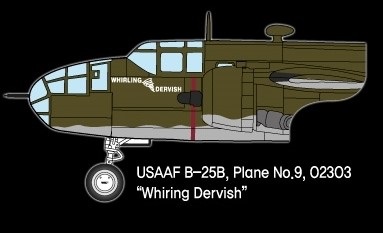
The profile at left comes comes from the Academy 13202 USAAF B-25B Doolittle Raid 1/48 scale plastic kit, whose decal sheet provides this option for the B-25 Mitchell among several others. Other companies have produced very similar versions of the “Whirling Dervish” design so I have no reason to doubt it.
It is also interesting to note that the 2001 film Pearl Harbor, the Touchstone Pictures $140 million extravaganza, shows this same insignia on the “Whirling Dervish” during the Doolittle Raid scene. It is unclear to me where the design originated but presumably Touchstone must have had a reference. I captured the still below from Pearl Harbor.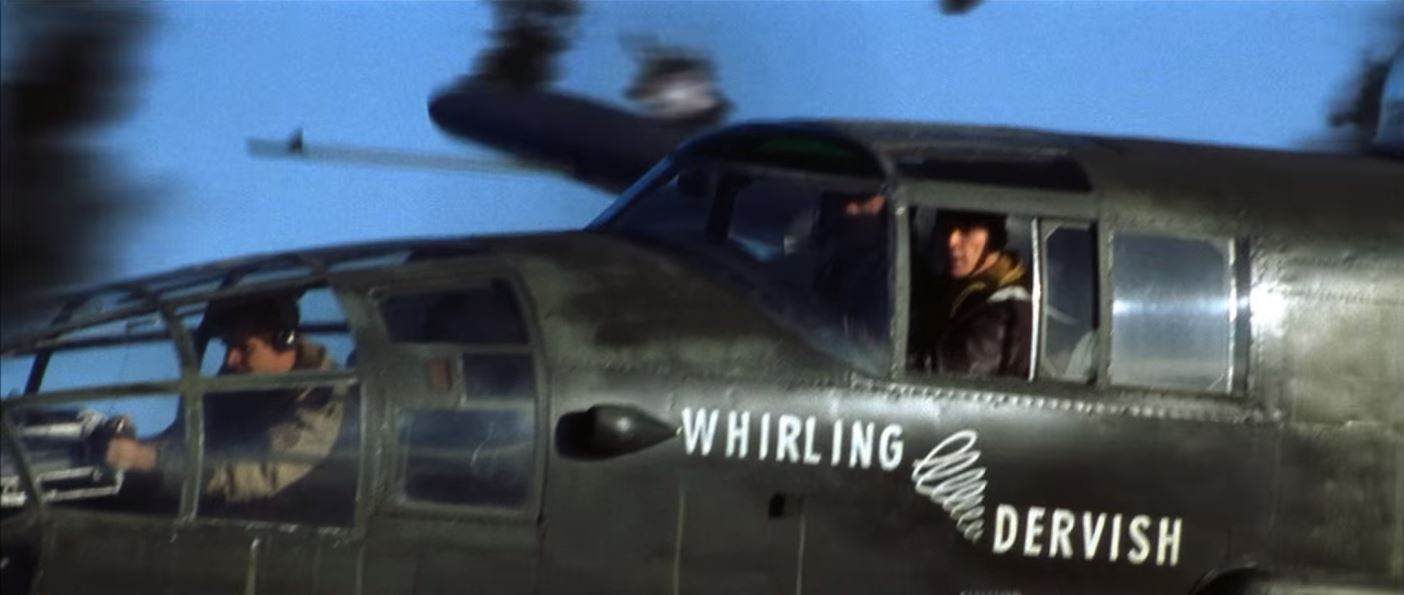 Incidentally, the details of the Doolittle Raid sequence in Pearl Harbor are about as accurate as those in a Disney movie. Still, a flawed war history movie — even accounting for the gratuitous romantic nonsense — is better than no movie, particularly in this case where the film actually follows the general outlines of the real raid.
Incidentally, the details of the Doolittle Raid sequence in Pearl Harbor are about as accurate as those in a Disney movie. Still, a flawed war history movie — even accounting for the gratuitous romantic nonsense — is better than no movie, particularly in this case where the film actually follows the general outlines of the real raid.
The “Whirling Dervish” design won’t set the world spinning faster (lame pun intended) but it’s interesting and worthy of consideration.
40-2267: “TNT”
The penultimate Mitchell to take off from the Hornet, the “TNT,” piloted by Lt. Donald G. Smith, was assigned to drop its bombs on an aircraft factory and shipyard on the outskirts of Kobe. After completing its mission, the “TNT” barely managed to reach the coast of China, where it crash landed at sea, staying afloat long enough for the five-man crew to safely board their rubber raft before the plane sunk. Though the raft was subsequently punctured when it hit the tip of one of the plane’s broken flaps, all five were able to swim to shore.
It bears mentioning that one of the five crew members of the “TNT” was the flight surgeon for the entire mission, Lt. Thomas “Doc” White, a Caltech and Harvard Medical School graduate who was also trained as a pilot, navigator, and bombardier. Through divine providence, the “Ruptured Duck” had also crash landed at sea less than a mile from the “TNT” and three of its four surviving members required medical attention. Once on land, the two crews connected and “Doc” White was able to provide medical care to the three “Ruptured Duck” crew members, saving Lawson’s life, though the flight surgeon had to amputate Lawson’s leg.
The profile below comes from the aforementioned Academy 13202 USAAF B-25B 1/48 scale plastic kit, whose decal sheet provides this Doolittle Raid option for the B-25 Mitchell among several non-Raid others.
Although the design appears to be widely accepted by plastic model and decal manufacturers, I’m at a loss about its origin. Lawson clearly states in the passage cited above from Thirty Seconds that “one fellow painted the chemical formula for TNT on the side of the ship.”
The design above is not the “chemical formula for TNT” mentioned by Lawson and, as far as I know, there is no photographic support for it, though I’d be delighted to be proven wrong. 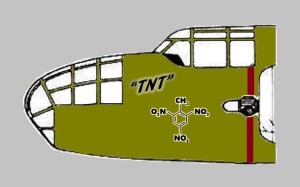
Thus, in the absence of photographic documentation, I think a reasonable and more accurate design, based strictly on Lawson’s quote in Thirty Seconds, would be the one at left, which I drew from scratch.
Ok, I get it, I’m not an artist by any stretch of the imagination. Nonetheless, this notional design, crude as it is, is more faithful to Lawson’s description than the others currently available.
Other Options
The blockbuster movie Thirty Seconds Over Tokyo, released by MGM in 1944, provides some tantalizing possibilities. Bearing in mind that all 16 bombers were lost during the raid, including the one captured and later destroyed by the Russians, it’s patently obvious that the “insignias” used in the film had to be reconstructed from pilots’ memories. Still, the movie is not a frivolous reference as it was released in 1944, when memories were still fresh, and employed Ted Lawson, upon whose book the movie was based, as a consultant. Coincidentally, Dalton Trumbo, the subject of a recent movie himself, wrote the screenplay for Thirty Seconds. (As an aside, Trumbo’s Johnny Got His Gun, written just before the war, probably left a greater impression on me as a kid than any other anti-war novel.) At any rate, I captured the stills below from the movie.
“Turkey”
At 31:17, one gets an excellent view of the “Turkey,” referenced in the movie. To be clear, those are 500 lb. bombs falling out of the bird’s behind. 
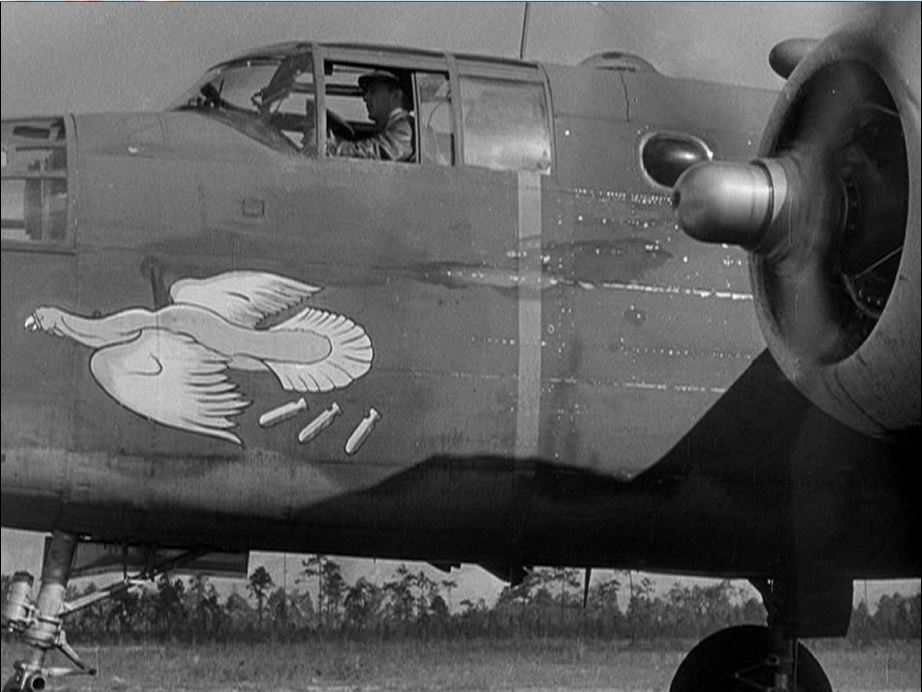 “Our Little Nell”
“Our Little Nell”
At 55:31, one can see “Our Little Nell.” This design, too, was probably created specifically for the movie but would still look cracking on a B-25 diecast model.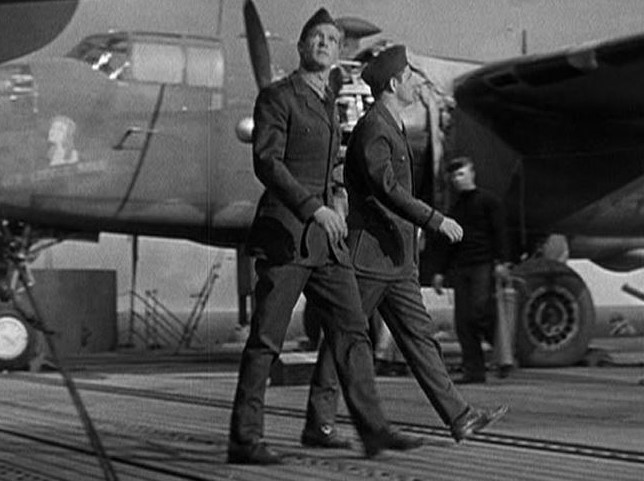 “Ruptured Duck”
“Ruptured Duck”
At 31:47, one gets a similar view of the “Ruptured Duck.” This last lagniappe photo is included for the sake of completeness and to point out that the Donald Duck design is identical to the one on the Corgi model. The one on the actual “Ruptured Duck,” however, may have been just slightly different, with Donald Duck wearing a sidecap.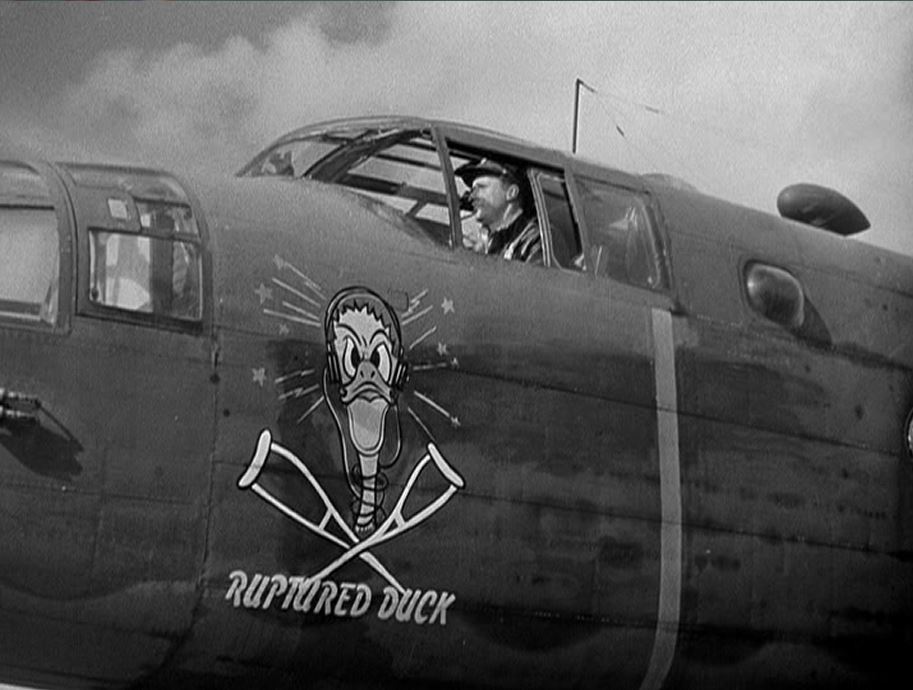 The Upshot
The Upshot
Diecast companies reportedly visit internet collector forums for information to improve their products. Thus, the goal of this post is to persuade Corgi and Air Force 1 that it’s high time to release another Doolittle Raid B-25 Mitchell with a new livery. My unequivocal choice would be the “Hari Kari-er.” In addition to the beautiful curvaceous angel design, the “Hari Kari-er” was probably the first American plane to shoot down a Japanese Hien and possibly the first American plane to carry a pin-up on its fuselage during the war. Furthermore — and perhaps more importantly — there is ample photographic documentation for it.
I hope you enjoyed these four Doolittle Raid posts. Thank you for your indulgence and, as always, comments, questions, corrections, and observations are welcome.

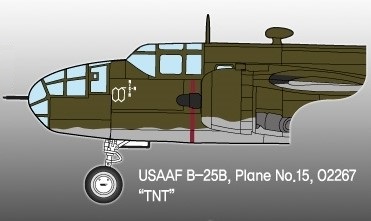
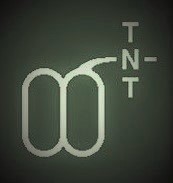
Dirk P Reynolds says:
How do you get parts 1 – 3 on Doolittle?
chules says:
Hello Dirk,
Thank you for visiting the website. Pursuant to your question, I have added links to each of the four parts so that you may easily link to the other parts. I hope that’s responsive to your question.
By the way, in Part 4, I made a plea for Corgi to produce a model of #40-2249 “Hari Kari-er.” Unbelievably, they listened. “Hari Kari-er” was released as Corgi Aviation Archive Collector Series AA35313.
Warm regards,
chules
EY says:
Hi chules, I have been thinking about using the TNT nose art with the Airfix B-25B, and propose that it may have been similar to this. Ed Saylor mentions in his interview that the official name (TNT) was painted on the plane. I wonder if the art with two rings is a misinterpretation of a verbal description – in shorthand, the three lines in the benzene ring are represented by a circle – I wonder if someone didn’t understand what was described to them, and put two “rings” next to each other, instead of having a circle inside a hexagon.
chules says:
Eric,
I completely agree with you about the “TNT” design and it’s the same design that I so crudely drew for this post. We also got validation on the design from John Mollison (JSM), who studies and illustrates aircraft professionally. Please take a look at his comment below.
Your proposed design
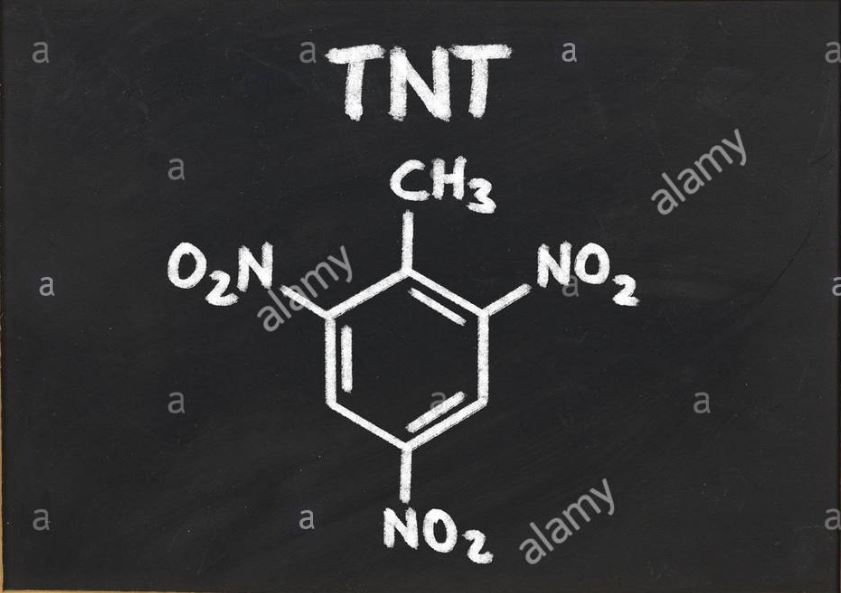
John Mollison’s design
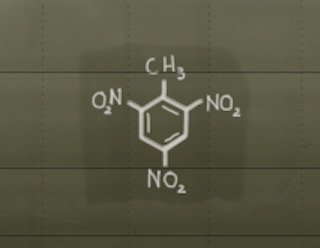
My proposed design
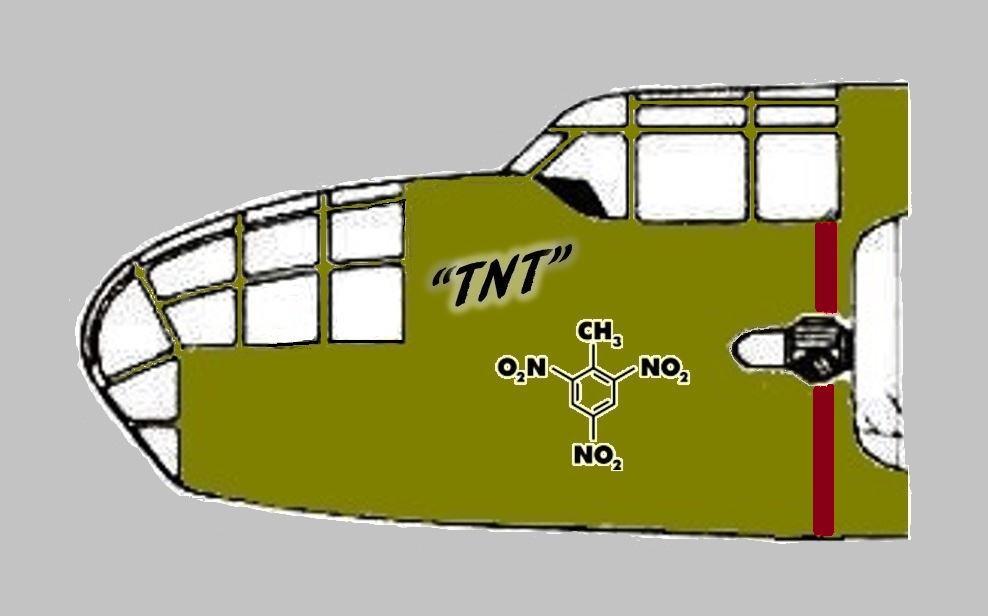
Your explanation for how the design got mangled is totally plausible and reminded me of a similar but more consequential misunderstanding. In 1566, Diego de Landa, the Franciscan Bishop of Yucatan, wrote a text on Mayan culture that included an “alphabet.” The “alphabet” proved unworkable and Mayan hieroglyphs went undeciphered for centuries. In 1952, Yuri Knorosov, a brilliant Russian linguist (who had never been to the Yucatan), concluded that Landa had merely written his “alphabet” as he heard it from his source, not quite understanding what was being said. Knorosov correctly concluded that the Mayans used a syllabary and the “letters” given to Landa were actually syllables. With that understanding, Landa’s syllabary proved useful after all and, combined with insightful breakthroughs from other linguists, we can now read Mayan texts in almost their entirety.
chules
JSM says:
https://ww2fighters.blogspot.com/2019/02/profile-134-april-18th-project-post-3.html
Thank you…we agree on this particular nose art.
chules says:
John,
Thank you for the comment and for visiting the site. Thank you also for some validation on the “TNT” nose art design. It means a lot coming from someone who studies and illustrates aircraft. I think your design is dead-on and you thought it through more than I did. First, you’re right that it would have been scrawled by hand rather than as a neat formula drawn with a ruler. And secondly, the design would have been in white as the pilots had chalk available to them. For those interested, below is John’s design. You can read more about it at his website. By the way, I spent this morning browsing through the website. It’s pretty awesome and certainly worth a visit. Congratulations.
Warm regards,
chules
Ara says:
Fantastic article chules, like all your work, you are clear with your information and cull many sources so that conclusions make themselves. Your table of the attack planes is exceptional. Nicely written and illustrated from start to finish. I want to read more about April 18th!
Ronald Greene says:
Hello, great info in your posts. I recently re-read Thirty Seconds over Tokyo again when David Thatcher passed away and I have a suggestion as to the naming of planes in Lawson’s book.
His book covers their training and the mission. His aircraft was named during training; so must have the others. 24 planes and crews were originally selected for the mission but upon arriving at Alameda if one had a problem or a crewman had a problem it was rejected. Lawson mentions this in the book and it is shown in the film as well. Since 16 were loaded onto the Hornet, eight others were left behind. They would be where the non known raid names would be.
chules says:
Ronald,
Thanks for the comment and for visiting the website. Your explanation is simple and makes total sense. I wish I’d thought of it and pointed it out. Please don’t hesitate to provide this kind of insight in the future.
Regards,
chules